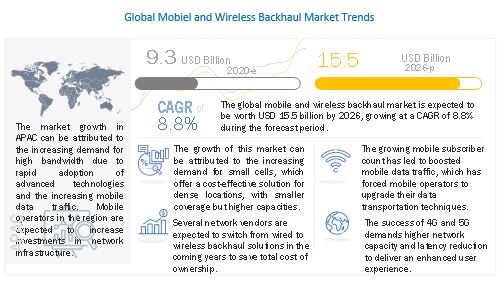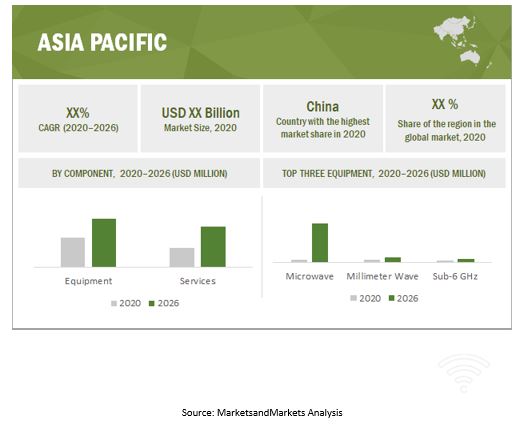< Key Hightlight >
The global Mobile and wireless backhaul Market size is expected to grow from USD 9.3 billion in 2020 to USD 15.5 billion by 2026, at a Compound Annual Growth Rate (CAGR) of 8.8% during the forecast period. Growth in mobile subscriber count, growing adoption of small cells, success of 4G and 5G, and need for lower total cost of ownership are expected to be the major factors driving the growth of the Mobile and wireless backhaul Market.

To know about the assumptions considered for the study, download the pdf brochure
COVID-19 Impact on the Global Mobile and wireless backhaul Market
Owing to the outbreak of COVID-19, various countries follow strict lockdowns, shutdowns, and mobility restrictions to avoid the spread of the virus. Closure of borders, stringent lockdowns, and supply chain issues act as restraining factors for the onsite deployment of mobile and wireless backhaul equipment. The pandemic also has disrupted business efficiency and employee productivity across the globe. Telecom operators and enterprises have reduced their operational spending and are now focusing more on business continuity and sustainability. The demand for Mobile and wireless backhaul has increased manifolds during the pandemic as the use of mobile data has increased. Hence, the market is expected to grow post the pandemic.
Mobile and wireless backhaul Market Dynamics
Driver: Growth in mobile subscriber count
The number of mobile internet users around the world is rapidly increasing due to the increasing smartphone penetration and enhanced connectivity. The increased internet connectivity around the world has led to boosted mobile data traffic. As a result of traction in the mobile data traffic, the demand for network capacity has enormously increased. To fulfill this need for high capacity, along with delivering quality services, mobile operators are forced to upgrade their data transportation techniques. This, in turn, has created a prospect for vendors in the mobile and wireless backhaul market to enhance their offerings. The market for mobile and wireless backhaul is extensively being driven by high bandwidth demand.
Restraint: Spectrum crunch
At high congestion places, network is a poor and free spectrum is unavailable; backhaul and power is not readily available as well. Radio backhaul is one of the potential solutions for this issue; however, unit size reduction and throughput testing are must for the proper deployment of small cells. The demand for mobile and wireless backhaul is increasing rapidly, but corresponding increase in capacity is not seen. High demand for capacity is impacting the availability of spectrum and has created a crunch in it. Hence, network operators must come up with cost-effective alternatives to maximize the usage of limited spectrum. Over a period, if this issue of poor backhaul is not resolved, vendors may need to find alternative backhaul options.
Opportunity: Rise in demand for network connectivity to implement internet of things
With the rise of IoT, there has been an avalanche of data being added to networks and data processing. The increasing demand for networks to be IoT-ready is expected to create a significant opportunity for telecom service providers. The declining sensor prices have resulted in the increasing use of IoT sensors. Various organizations are implementing IoT solutions and looking to enhance their operations with the use of IoT in the future. Mobile and wireless backhaul solutions that provide scalability, low latency, and high performance and capacity can be a game-changer for IoT implementation. With the help of advanced backhaul solutions, operators would be able to meet IoT requirements and enable communication, and exchange data and derive actions from daily use physical objects. The increasing demand for network connectivity for IoT implementation is expected to boost global market growth in the upcoming years.
Challenge: Health issues related to microwave
Several people are not aware of the harmful effects of Radiofrequency Waves (RF) and their role in cancer and other serious risks. Scientific evidence suggests that cancer is not only linked to mobile phone radiation and that other factors also may be involved in its development. Most mobile operators use from radiofrequency waves in the range of up 300 MHz to 3 GHz that can be harmful to human health. One study published in 2015 in Military Medical Research says too much microwave radiation can cause brain dysfunction and structural brain damage and could cause headaches, fatigue, memory loss, and impaired learning. However, depending on the amount of exposure, microwave radiations do not have direct hazards to human health. The harmful effects of electromagnetic radiation increased with the rising exposure to the electromagnetic spectrum. The hazards of microwave radiations can be reduced if safety regulations are considered while designing and manufacturing devices that use microwave radiation, especially in its antennas, such a smart antenna that reduce the power level of the microwave radiations.
By Component, the Services segment to have a higher growth during the forecast period
The Services component of the Mobile and wireless backhaul Market is expected to have a higher growth rate during the forecast period. Services enable strategizing for an efficient, comprehensive, and programmable backhaul transport solution, minimizing costs, and maximizing operational efficiency. The service providers in the mobile and wireless backhaul market provide consulting for deploying the most appropriate topologies and network architectures to simplify the transformation of mobile transport networks.
By Network technology, the 4G segment to dominate the market during the forecast period
4G LTE has brought several important changes, which include higher backhaul capacity to cells and the use of Multiple Input Multiple Output (MIMO) antennas to increase the capacity of air interference between towers and User Equipment (UE). 4G operates in bands up to 6GHz with a peak speed of 1GB per second. It offers enhancements such as improved peak bandwidth and greater energy efficiency for IoT connections. The success of 4G LTE has placed even greater challenges on mobile operators as they strive for more network capacity, latency reduction, and the need to deliver an enhanced user experience.
By Region, Asia Pacific to record the highest growth during the forecast period
The APAC Mobile and wireless backhaul Market is estimated to have strong growth in the future. With the constant rise in the mobile data traffic, APAC tends to hold significant potential in terms of backhaul deployments as the region is witnessing major spending in the market. The transition of mindsets from traditional wired backhaul to wireless links has been leading to large-scale investments in the telecom industry. Owing to a large number of 5G deployments and initiatives taken by major Asian mobile operators to resolve the problem of high bandwidth requirements, the mobile and wireless backhaul market in APAC is expected to anticipate enormous growth in the coming years.

Key Market Players
The report includes the study of key players offering mobile and wireless backhaul solutions and services. It profiles major vendors in the global Mobile and wireless backhaul Market. The major vendors in the Market include Ericssom (Sweden),Huawei(China), Nokia(Finland), NEC Corporation(Japan), ZTE(China), Fujitsu(Japan), Broadcom(US), Ceragon(Israel), Aviat(US), and SIAE(Italy). These players have adopted various strategies to grow in the global Market.
The study includes an in-depth competitive analysis of these key players in the Mobile and wireless backhaul Market with their company profiles, recent developments, and key market strategies.
Scope of the report
Report Metric | Details |
Market size available for years | 2016-2026 |
Base year considered | 2020 |
Forecast period | 2020-2026 |
Forecast units | Value (USD Million) |
Segments covered | By Component, Equipment, Services, Nework technology, Region |
Regions covered | North America, Europe, APAC, MEA, Latin America |
Companies covered | Ericssom(Sweden), Huawei(China), Nokia(Finland), NEC Corporation(Japan), ZTE(China), Fujitsu(Japan), Broadcom(US), Ceragon(Israel), Aviat(US), SIAE(Italy), Proxim Wireless(US), Intracom Telecom(Greece), AR RF/Microwave Instrumentation(US), Redline(Canada), DragonWave-X(US), E-Band(US), CBNG(UK), Radwin(Israel), CableFree(UK), CommScope(US), CCS(UK), Siklu(US), Blu Wireless(US), Fastback(US), Eravant(US), BLiNQ(Canada), and EC SYSTEM(Czech Republic). |
This research report categorizes the Mobile and wireless backhaul Market to forecast revenues and analyze trends in each of the following subsegments:
By Component:
By Equipment:
- Microwave
- Millimeter Wave
- Sub-6 GHz
By Servcies:
- Designing and Consulting
- Integration and Deployment
- Support and Maintenance
By Network technology:
By Region:
- North America
- Europe
- APAC
- MEA
- Kingdom of Saudi Arabia
- United Arab Emirates
- Rest of MEA
- Latin America
- Brazil
- Mexico
- Rest of Latin America
Recent Developments:
- In December 2020, Nokia partnered with Zain Saudi Arabia (Zain KSA), a few of first 5G network operators, for rolling out 5G network to KSA for Nokia’s end-to-end portfolio that includes backhaul, where thousands of 5G sites will be deployed to bring faster speeds and higher quality networking services across the region.
- In July 2020, Ericsson partnered with US Cellular to supply its series of millimeter-wave equipment for backhaul transport solutions.
- In June 2020, ZTE partnered with China Telecom to deploy a 5G commercial ultra-broadband Qcell digital indoor distribution system. This was mainly deployed in high data traffic areas such as shopping malls and subway stations.
- In September 2019, India Bharti and Huawei partnered to launch 5G microwave enhanced MIMO technology. This solution of 5G microwave Huawei and Bharti India is able to deploy more than 100 MIMO microwave links able to deliver 1Gbps capacity over a single 28Mhz spectrum.




